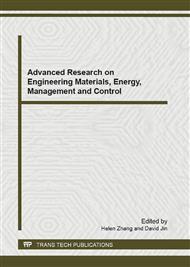[1]
M. J. Zhang, On constructing a molecular computer, in DNA Based Computers, ser. Discrete Mathematics and Theoretical Computer Science (DIMACS), R. Lipton and E. Baum, Eds. Providence, RI: Amer. Math. Soc., pp.1-21 (1996).
DOI: 10.1090/dimacs/027
Google Scholar
[2]
M. Zhang, M. X. Cheng and T. J. Tarn, A mathematical formulation of DNA computation, IEEE Trans. on Nanobioscience, vol. 5, pp.32-40 (2006).
DOI: 10.1109/tnb.2005.864017
Google Scholar
[3]
R. Gao, J.Y. Yu, M. Zhang, T.J. Tarn, J.S. Li. A Mathematical Formu- lation of the Central Dogma of Molecular Biology,. In Nanomedicine: A System Engineering Approach, M. Zhang and N. Xi. Singapore: Pan Stanford Publishing Pte. Ltd., pp.81-116 (2009).
DOI: 10.1142/9789814241373_0003
Google Scholar
[4]
E. S. Lander and P. Green, Construction of multilocus genetic linkage maps in humans, in Proceedings of the National Academy of Sciences of the United States of America, vol. 84, pp.2363-2367 (1987).
DOI: 10.1073/pnas.84.8.2363
Google Scholar
[5]
G. A. Churchill, Stochastic models for heterogeneous DNA sequences, Bull Math. Biol., vol. 51, pp.79-94 (1989).
Google Scholar
[6]
J. V. White, C. M. Stultz and T. F. Smith, Protein classification by stochastic modeling and optimal filtering of amino-acid sequences, Math. Bios, vol. 119, pp.35-75 (1994).
DOI: 10.1016/0025-5564(94)90004-3
Google Scholar
[7]
K. Asai, S. Hayamizu and K. Onizuka, HMM with protein structure grammar, in Proceedings of the Hawaii International conference on System Sciences, pp.783-791 (1993).
DOI: 10.1109/hicss.1993.270612
Google Scholar
[8]
S. R. Eddy, Hidden Markov models, Curr. Opin. Struct. Biol., vol. 6, pp.361-365 (1996).
Google Scholar
[9]
S. R. Eddy, Multiple alignment using hidden Markov models, ISMB, vol. 3, pp.114-120 (1995).
Google Scholar
[10]
P. Baldi, Y. Chauvin, T. Hunkapillar and M. A. McClure, Hidden Markov models of biological primary sequence information, Proc. Natl. Acad. Sci., vol. 91, pp.1059-1063 (1994).
DOI: 10.1073/pnas.91.3.1059
Google Scholar
[11]
Krogh, M. Brown, I. S. Mian, K. Sjölander and D. Haussler, Hidden Markov models in computational biology. Applications to protein modeling, J. Mol. Biol., vol. 235, pp.1505-1531 (1994).
DOI: 10.1006/jmbi.1994.1104
Google Scholar
[12]
R. Gao, J.Y. Yu, M.J. Zhang, T.J. Tarn, and J.S. Li. Systems Theoretic Analysis of the Central Dogma of Molecular Biology: Some Recent Results, , IEEE Trans. on NanoBioscience, vol. 9, no. 1, pp.59-70 (2010).
DOI: 10.1109/tnb.2010.2041065
Google Scholar
[13]
F. H. C. Crick, Central dogma of molecular biology, Nature, vol. 227, pp.561-563 (1970).
DOI: 10.1038/227561a0
Google Scholar
[14]
F. H. C. Crick, On protein synthesis, Symp. Soc. Exp. Biol., XII, pp.139-163 (1958).
Google Scholar
[15]
G. J. Mitchison and R. M. Durbin, Tree-based maximal likelihood substitution matrices and hidden Markov models, J. Mol. Evol., vol. 41, pp.1139-1151 (1995).
DOI: 10.1007/bf00173195
Google Scholar


